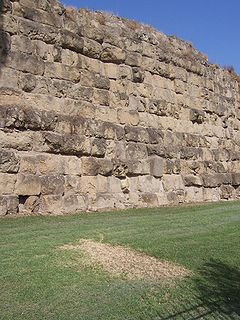Related Research Articles

Marcus Furius Camillus was a Roman soldier and statesman of the patrician class. According to Livy and Plutarch, Camillus triumphed four times, was five times dictator, and was honoured with the title of Second Founder of Rome.

The gens Manlia was one of the oldest and noblest patrician houses at Rome, from the earliest days of the Republic until imperial times. The first of the gens to obtain the consulship was Gnaeus Manlius Cincinnatus, consul in 480 BC, and for nearly five centuries its members frequently held the most important magistracies. Many of them were distinguished statesmen and generals, and a number of prominent individuals under the Empire claimed the illustrious Manlii among their ancestors.

The Battle of the Allia was a battle fought c. 387 BC between the Senones – a Gallic tribe led by Brennus who had invaded northern Italy – and the Roman Republic. The battle was fought at the confluence of the Tiber and Allia rivers, 11 Roman miles north of Rome. The Romans were routed and Rome was subsequently sacked by the Senones. According to scholar Piero Treves, "the absence of any archaeological evidence for a destruction-level of this date suggests that [this] sack of Rome was superficial only."
The Roman–Volscian wars were a series of wars fought between the Roman Republic and the Volsci, an ancient Italic people. Volscian migration into southern Latium led to conflict with that region's old inhabitants, the Latins under leadership of Rome, the region's dominant city-state. By the late 5th century BC, the Volsci were increasingly on the defensive and by the end of the Samnite Wars had been incorporated into the Roman Republic. The ancient historians devoted considerable space to Volscian wars in their accounts of the early Roman Republic, but the historical accuracy of much of this material has been questioned by modern historians.
Lucius Furius Medullinus, of the patrician gens Furia, was a politician and general of the Roman Republic who was consul twice and Consular Tribune seven times.
Gaius Servilius Ahala was a three time consular tribune, in 408, 407 and 402 and one-time magister equitum, in 408 BC, of the Roman Republic.
Lucius Julius Iulus was a member of the ancient patrician house of the Julii. He held the office of military tribune with consular powers in 388 BC, and again in 379.
Aulus Cornelius Cossus was a politician and general in the early Roman Republic who was appointed dictator in 385 BC to quell the alleged revolution of Marcus Manlius Capitolinus.
Quintus Sulpicius Camerinus Praetextatus was a consul or consular tribune of the Roman Republic in 434 BC.
Titus Quinctius Poenus (Pennus) Cincinnatus was a consul of the Roman Republic in 431 and 428 BC and a consular tribune in 426 BC. He might have been consular tribune again in 420 BC.
Gaius Valerius Potitus Volusus was a consul in 410 and consular tribune in 415, 407 and 404 BC of the Roman Republic.
Lucius Valerius Potitus was a five time consular tribune, in 414, 406, 403, 401 and 398, and two times consul, in 393 and 392 BC, of the Roman Republic.
Manius Aemilius Mamercinus was a three time consular tribune, in 405, 403 and 401 and one-time consul, in 410 BC, of the Roman Republic.
Gnaeus Cornelius Cossus was a consular tribune of the Roman Republic in 406, 404 and 401 BC.
Aulus Manlius Vulso Capitolinus was a consular tribune of the Roman Republic in 405, 402 and 397 BC.
Manius Sergius Fidenas was a consular tribune of the Roman Republic in 404 and 402 BC.
Publius Cornelius Maluginensis was a consular tribune of the Roman Republic in 404 BC.
Lucius Lucretius Tricipitinus Flavus was a Roman statesman and general who had a prominent career in the early 4th century BC, serving once as consul, and four times as consular tribune, as well as perhaps serving as Princeps senatus.
Appius Claudius Crassus Inregillensis was a consular tribune of the Roman Republic in 403 BC.
Lucius Aemilius Mamercinus was a Roman politician and general who, in the early 4th century BC, held the office of consular tribune an extraordinary six times in his distinguished, yet mostly unknown, career.